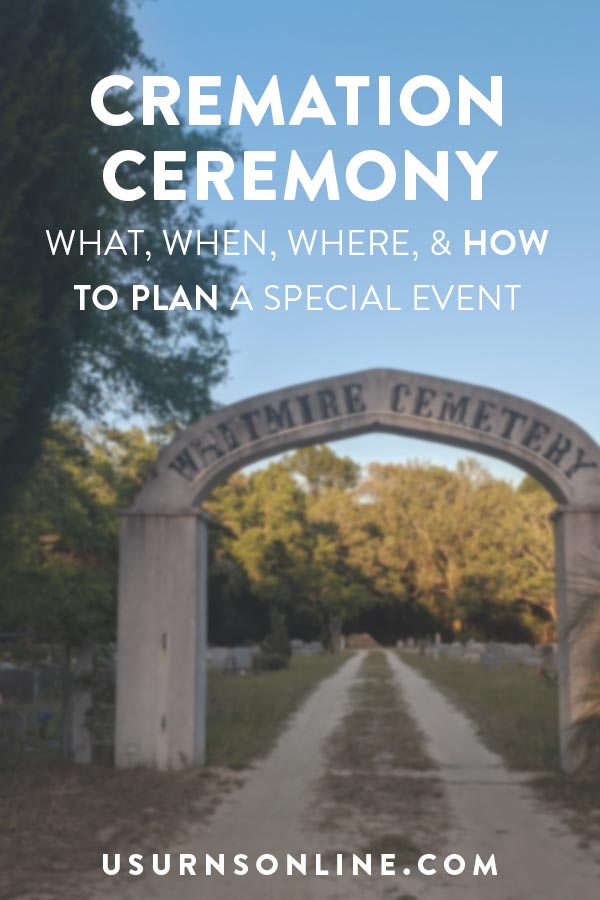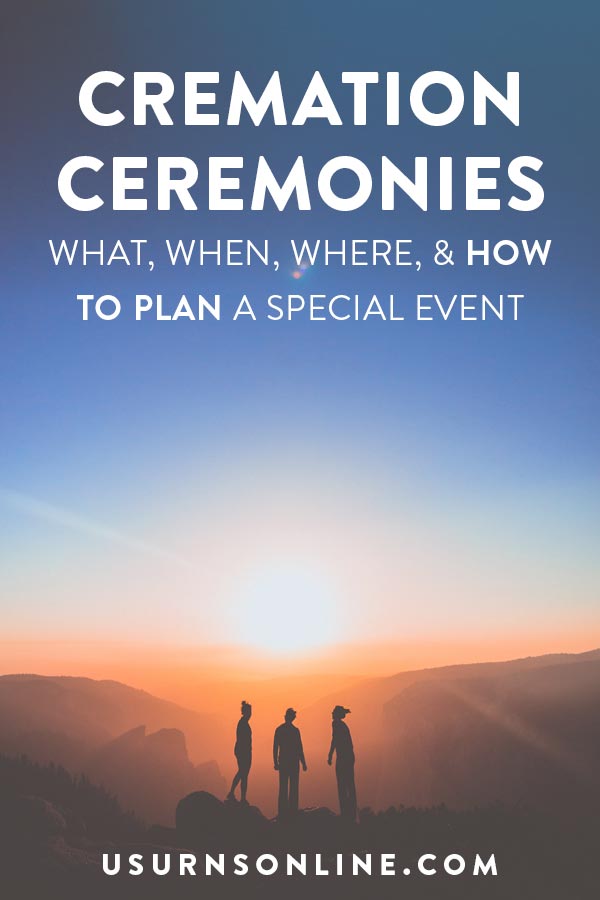You have many options when it comes to holding a cremation ceremony. Today, we’re going to go over the different types of cremation ceremonies and also discuss when, where and how they may occur.
You’ll learn what a cremation ceremony is, how to plan one for a loved one, whether you wish to do so at a funeral home, your own home, or somewhere else, and much more.
Ready? Let’s begin.
What Is a Cremation Ceremony?
To start things off, it would be helpful to understand just what exactly a cremation ceremony is.
A cremation ceremony is a type of funeral service at which a loved one’s cremated remains are present, as opposed to the body in a casket. It may also refer to a ceremony that occurs at the time of cremation, or at the time of inurnment.
In this article we’ll be considering these and other types of cremation ceremonies:
- Ceremonies held while ashes are being inurned
- Scattering ceremonies
- Funerals with ashes present
- Viewings, visitations and wakes
- Memorial services
- Direct cremation
- Planning a home cremation ceremony
Importance of Cremation Ceremonies
Throughout history, funeral and cremation ceremonies have served as the nucleus for the grief process.
When a loved one passes away, family and friends who are left behind need a specific event, or a formal goodbye, to help them process their loss. The ceremony – a funeral, memorial service, or life celebration – serves as that event.
Psychologists agree that a funeral or cremation ceremony is a healthy way to say goodbye to someone who has died. These services bring us together, allow us a safe place to release our emotions, and most of the time afford us a bit more time in the presence of our loved one who has died.
All of this is important even if our loved one has been cremated, or will be.
Urns Made in the USA
Cremation Ceremony Ideas
You can incorporate many traditional memorial ideas (and less-traditional “celebration of life” ideas) into the ceremony.
Here are a few ceremony elements to get you started:
- Invite close friends and family members
- Consider asking a pastor, funeral director, or family member to lead the ceremony
- Dress up for the occasion
- Bring a photo to display
- Have someone say a few words or give a brief eulogy
- Invite those present to share stories or a favorite quote
- Sing a song (a hymn, a silly song, or the decedent’s favorite)
- Play a song (bring portable speakers)
- Say a prayer (here are some good ones)
- Bring the urn and have the ashes placed inside
- Have a reception afterwards (reserve a room at a restaurant, or potluck at someone’s home)
You don’t have to do every single one of those elements. Pick the ones that are meaningful to you and your family.
Types of Cremation Ceremonies
Ceremony at the Time of Cremation
Sometimes a cremation ceremony takes place at the time cremation occurs or is about to occur. This is known as a witness cremation.
Many funeral homes and crematories allow for this type of service as more and more people are turning to cremation over traditional burial.
During a witness cremation, family members watch the cremation process usually through a window of a small room adjacent to the crematory. These rooms are like small chapels or visitation rooms, complete with chairs, flowers, a guest book, maybe even refreshments.
Sometimes one family member, perhaps the next-of-kin, will help with placing the body into the retort, and may also be the one to start it, too. (Each facility has different policies and practices, so ask about these options.)
While it used to be that only certain cultures would wish to take part in a witness cremation, as death care becomes more modernized (and not something that must be “kept hidden” from family), more families who choose cremation are also opting to be there in person.
And because cremation can take several hours, this is a wonderful opportunity to hold a ceremony. If your family wishes for a witness cremation, be sure to speak with your funeral director to set up a time for the ceremony that coincides with the time of cremation.
Ceremony When Inurning the Ashes
Inurnment is the process of placing the cremated remains into an urn for display, or in anticipation of scattering, or even burial or water disposition. The term (“inurn”) can be compared to interment, which occurs when a body is buried or entombed.
Holding a ceremony while the ashes are being inurned is a healthy, healing way to say goodbye to your loved while also honoring the life they lived. It is a sacred moment that deserves just as much attention to detail as a funeral or any other ceremony.
Here are some ideas for making your loved one’s inurnment ceremony as special as they were.
Ceremony for Scattering Ashes
As cremation grows in popularity, scattering ceremonies are also gaining traction.
At a scattering ceremony, family and friends gather at a place of special significance to their loved one who’s passed. Someone opens the special scattering urn, which is holding the precious remains, allowing for the wind or water to carry the remains into evermore.
Just as at a traditional funeral service, during this sacred time prayers may be said, songs sung, memories shared, a eulogy can be spoken, and a sermon given.
Click here to learn more about planning a memorable scattering ceremony.
Urns Northwest has a wide array of beautiful scattering urns, many of which are eco-friendly and biodegradable. Click here to view all options.
Other Types of Ceremonies
Besides the cremation-centered ceremonies we’ve already mentioned, there are a few more ceremony types that can be held with either cremated remains or a casketed body present (and one type with neither present):
Funerals
Perhaps the most recognizable term in this list. A funeral ceremony can take place at a funeral home, church, and sometimes at home. A casketed body is usually present, but this is by no means a rule; cremated remains may also be present at a funeral service.
A traditional funeral service may include a eulogy, a sermon, praying, singing and sometimes dancing, and a visitation or viewing the night before.
These days, funerals are becoming more and more personalized as a way to further honor the life of the person who’s died; the possibilities for personalizing a funeral are virtually limitless.
Memorials
A memorial service is different from the other types of services we’ve mentioned so far. It is just what it sounds like: a service held in memory of someone who has died, without their remains present.
A memorial service may take place for a number of reasons:
- The ceremony had to be delayed and the body has already been interred or cremated.
- The family held a private inurnment ceremony or burial and plans to hold a memorial service for friends at a later date.
- The nature of the death means that it’s impossible for the body to be physically present.
It is important to remember that memorials are just as appropriate to the healing nature of such ceremonies; they still allow for a special time to come together and say goodbye to your loved one.
Discover some creative memorial service ideas here.
Graveside Service
Also known as the committal service or simply the committal, a graveside service takes place at the cemetery. A graveside service may be a separate, additional service following the funeral; in fact, many funeral homes offer a short graveside service as part of a funeral service package.
If your loved one has been cremated, you can still hold a graveside service for them if burial is desired. However, you may require a certain type of urn.
For more details, see How Are Cremation Urns Buried?
Celebration of Life
A celebration of life takes a step back from the somberness of a traditional funeral. It’s more of a party, so to speak, with the focus placed on happy memories of the deceased and the life they lived. And just like with the other ceremonies we’ve discussed so far, it’s perfectly fine for cremated remains to be present.
If a celebration of life sounds like something your loved one would have wanted, we’ve compiled a huge list of unique celebration of life ideas to inspire you.
Viewing/Visitation/Wake
A viewing or visitation is the ceremony traditionally occurring prior to the funeral, usually the evening before. It may also happen right before a funeral, or technically at any time the family wishes.
While the terms viewing and visitation are interchangeable in everyday lingo, they do differ slightly in definition. At a viewing, the casketed body (or urn) is present, for family and friends to view and say goodbye to
At a visitation, the emphasis is on visiting with said family and friends. The casket or urn may or may not be present. Learn more about visitations (and viewings) here.
A wake is more of a religious term that is also sometimes synonymous with the terms viewing or visitation. It is a common element of Catholic funerals; read this for more information about wakes, how they started, and what they are like nowadays.
Direct Cremation
As cremation rates rise across the U.S., so does the trend of direct cremations.
A direct cremation is a cremation ceremony without any ceremonial components. Because it is often much more cost-efficient than a traditional funeral service, there is also much more room (and budget room) for a family to create and plan their own funeral service for their loved one.
Read more about direct cremation here.
That leads us to the next type of ceremony, perhaps the most versatile on our list…
Ceremony at Home (or Wherever You Want)
We’ve already seen that cremation ceremonies can occur at the funeral home, at a church, or at the cremation chamber itself in the form of a witness cremation.
But did you know that you can hold a funeral or cremation ceremony right from the comfort of your own home? My family has actually done this.
When my husband’s great uncle died, a direct cremation occurred and then we held his funeral at my in-law’s home.
It was lovely – the weather was nice that day, so the ceremony took place on the back porch. We set up some chairs for guests, everyone still wore funeral attire, the pastor came and said some words. My mother-in-law even gave a eulogy, right next to the table where we’d placed the urn.
There was a guest book back in the house for everyone to sign, as well, along with lunch. It was a unique, comforting (and comfortable) service that I’ll always remember.
So if you’re planning for cremation (especially a direct cremation), it doesn’t mean that you can’t do a memorial service of some sort.
Besides your home, you can plan a cremation ceremony pretty much anywhere: a local park, on the beach, on a mountainside, or another place that was special to your loved one and their family.
If you plan on scattering the ashes too, do keep in mind that some local governments have rules and regulations concerning where you can scatter.
Urns Northwest is one of the nation’s leading providers of high-quality cremation urns. To find the perfect urn for your loved one’s cremation ceremony, check out our Featured Collections today.
Creatively Honoring Your Loved One
As you can see, cremation ceremonies take a bit of planning, but with the right help and resources, anyone can do it.
While a good funeral director, an involved pastor, celebrant, or other end-of-life advocate will go out of their way to help you, those of us here at Urns Northwest and US Urns Online are also standing by to assist you with all your cremation urn needs, questions, and concerns.
So leave a comment below with questions about ceremonies and funeral planning, or drop a line here if you have questions about our cremation urns.
And before you go, here are some more topics that may be of interest to you:
- Funeral Planning Guide: How to Plan a Funeral
- How do I arrange a cremation?
- 12 Incredibly Popular Cremation Urns
Pin It






It’s a great point that you need to remember to invite some close friends and family members to the ceremony. My sister is thinking about getting her funeral planned soon so that she doesn’t have to worry about it in the future. I think it’s a great idea to reach out to a local funeral home that can help her get her plans finalized.
Do people usually have people attend the cremation? My SIL was mad because she was not included. I did not think to invite anyone. It was only me and my 2 daughters.
Hi Deanna,
As cremation becomes more common, what is “usual” is rapidly changing. I’d say no, historically most people don’t usually attend the cremation or have a “cremation ceremony” like our article describes. However, we’re seeing it happen more and more. We’re somewhere in between the old way of doing the traditional viewing/funeral and then the casket is wheeled away behind closed doors for the cremation, and not quite to the point where attending the cremation is a typical “funeral event.” So it really depends on the family, what you want to do, etc. You and your two daughters attending is completely within today’s normal bounds. At the same time, your SIL isn’t wrong in thinking that she might have been invited to attend. Ultimately it’s up to the immediate family, and your decision (or simply not thinking about it) is fine – losing a loved one AND planning the funeral is very difficult! I hope this helps.